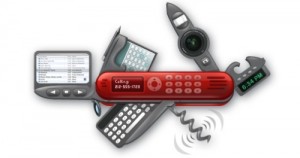 What are the key things that you check are in your pocket when you leave the house? In days gone by, before the era of mobile phones, before credit cards and while some people still had housekeepers, the only important thing to have on you when you left the house was money. This was what enabled you to get to work, to pay for lunch and maybe dinner and then get home again. As we moved into the 50s and 60s, we added the house key to this list as there wasn’t always someone else at home to let us back in, and now as we passed through the 90s we added the mobile phone to our pockets. So over time we’ve moved from 1, to 2, and now these 3 key items that we can’t be without, whether it is our bulging wallet full of cash, credit, store and loyalty cards, or the ever growing bunch of keys to the house, the office and the car or finally, what is quickly becoming our most treasure possession the smartphone with it’s email access, calendar and address book.
What are the key things that you check are in your pocket when you leave the house? In days gone by, before the era of mobile phones, before credit cards and while some people still had housekeepers, the only important thing to have on you when you left the house was money. This was what enabled you to get to work, to pay for lunch and maybe dinner and then get home again. As we moved into the 50s and 60s, we added the house key to this list as there wasn’t always someone else at home to let us back in, and now as we passed through the 90s we added the mobile phone to our pockets. So over time we’ve moved from 1, to 2, and now these 3 key items that we can’t be without, whether it is our bulging wallet full of cash, credit, store and loyalty cards, or the ever growing bunch of keys to the house, the office and the car or finally, what is quickly becoming our most treasure possession the smartphone with it’s email access, calendar and address book.
But, we are on the cusp of a change – much to the ignorance of the majority of the population, scores of companies across the world are trying to turn this phenomenon around, taking this growing list and sending it scuttling in the other direction, as we start to cram everything back into a simple device. So below a look at these organisations and how they are trying to kill your keys, and your wallet!
Replacing our keys:
Apple iKey: Talked about early this year, this application for the iPhone could allow the phone using a PIN code and NFC technology to unlock the front door, read the full article at Gizmag here. And check out this article to see 8 things that your iPhone will (probably) replace.
Passive Keyless Entry: PKE is the latest technology slowly creeping through the car market, beyond remote unlocking, these devices “provide the ultimate in user convenience, recognizing drivers and opening the car as they approach. Once the driver is in the drivers seat the engine is started by simply pressing a button (“Keyless Go”). Authorization, traditionally given by inserting the key into the lock, is granted automatically by a card or token carried by the driver” (from NXP).
Mobile boarding passes: Not that the boarding pass was really a key, but it served the same effect; as you can see from this NY times article and the latest update from American Airlines as well as the latest Blackberry App for British Airways passengers, boarding passes on your mobile phone could soon be the norm, ZDNet predicted this back in 2007, and we’re almost there.
Paying without your wallet:
SMS Short Codes: Simple as it seems, these are the easiest way to pay extra on your bill, services offered by your carrier have a special short code and you can pay by simply texting your request – the charge shows up on the bill.
Paypal Mobile: Not a wallet replacement, but a simple way to leave your credit cards at home, harnessing the power of mobile broadband and the PayPal systems.
OneBip & PayMo: Taking the SMS option one step further, these providers can open an account for you and act as a payment gateway between your mobile operator and other merchants, taking mobile payments to the next level.
Yoose: Rather than carry around an envelope full of the coupons you’ve been clipping, this coupon wallet for the phone does it for you, keeping them all in one place and making using them easy as 2 pies for the price of one!
Square: Potentially on the other end of the spectrum, the Square product allows anyone with an iPhone to take payment by credit card, so businesses don’t need to be carrying complex equipment or a register with them, and customers feel safer without giving away their card numbers.
The list could go on and on, as startups all over the place are vying for their position in your smartphone – it looks like the days of bulging pockets are soon to be over!


1 comment